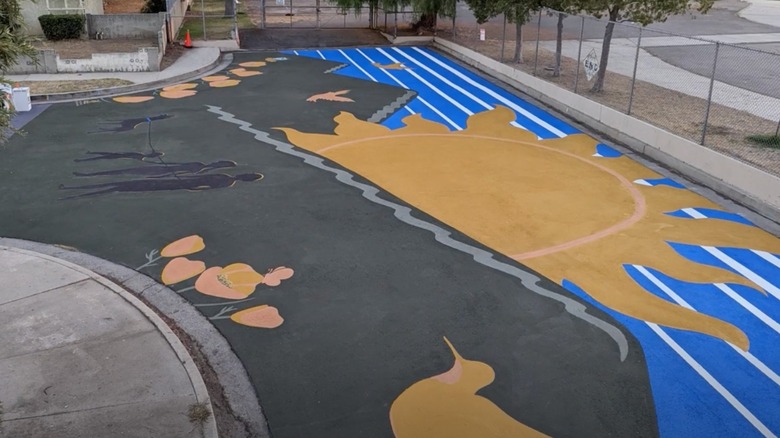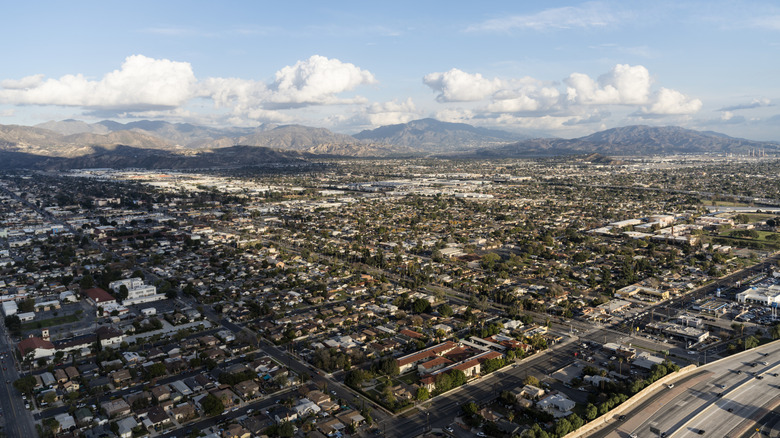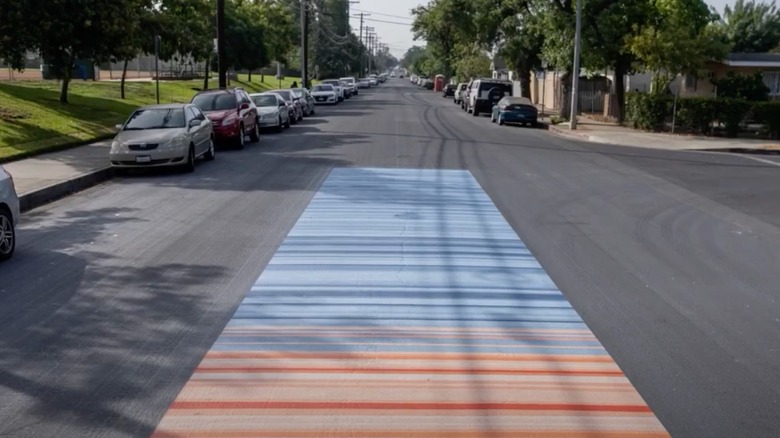A Vibrant, Historically Diverse LA Neighborhood Is Now One Of The Coolest, Thanks To An Innovative Plan
Just over the Hollywood Hills, in the heart of the San Fernando Valley, is one of Los Angeles' most historically diverse neighborhoods, which is tackling rising temperatures in an innovative way. Pacoima, located about 20 minutes north of Hollywood, was one of the few places where nonwhite residents could purchase homes in Los Angeles during the early to mid-20th century. It has remained a hub for Latino, Black, and Asian communities. In 2013, local artist Levi Ponce put Pacoima on the map by creating "Mural Mile," a stretch of buildings featuring playful takes on classics like "The Girl with the Hoop Earring" and the Mona Lisa as a Mexican warrior with a sombrero and dagger. Los Angeles has a number of once-blighted districts that have been transformed into burgeoning scenes of exciting art, and Pacoima is no exception. Ponce's project has turned it into one of the best places to see street art in the city.
In 2018, Pacoima added a new element to its vibrant public art scene: Bold cooling paint used on sidewalks and buildings to combat the area's rising temperatures. Pacoima is one of the hottest neighborhoods in the city due to a mix of climate change and "thermal inequalities," environmental effects caused by systemic oppression and issues linked to race and class. Pacoima is predominately a Latino neighborhood, which gets much hotter than whiter areas like Silver Lake. To address this extreme heat and its health risks, a group of nonprofits, community organizers, and council members came up with a plan: Paint sidewalks and buildings with sun-reflecting coating to bring temperatures down, making Pacoima one of the coolest neighborhoods around.
The long history of Pacoima
These days, Los Angeles has no shortage of diverse and artsy neighborhoods, but that wasn't always the case. To understand how Pacoima came to be, one has to go back to around A.D. 450 when the Tataviam tribe was the first to establish itself in the area, then called "Pacoinga Village." European colonizers decimated the community, and the area changed further after the 19th century Mexican-American War, in which the United States acquired California and other Southwestern states. It was established as "Pacoima" in 1887, and the initial plans for this newly American land was to turn it into an exclusive community for high-end settlers. A flood in 1891 squashed that plan, and instead, the area became agricultural land. It later drew people fleeing the Mexican Revolution in 1910, as Pacoima was one of the few places where minorities could buy homes amid widespread racially restrictive covenants elsewhere in Los Angeles.
While Pacoima's earliest residents were Indigenous, its population expanded to include Mexicans, Japanese, and African Americans residents. For a period after World War II, it was an enclave of the Black middle class, where those fleeing the Jim Crow South or returning from fighting in the war could buy homes. The city, in the midst of a housing shortage, quickly built homes marketed to this community. Over time, the Pacoima's African American population gave way to a predominately Latino one, and the area is known as such today. This long history of racial diversity has made Pacoima a significant and unique place in Los Angeles, but unfortunately, it also contributed to the development patterns that have made it one of the hottest neighborhoods in the county.
A way of cooling down Pacoima's heat
When the large housing blocks were built in Pacoima from the 1930s to the 1950s, air conditioning and insulation weren't so commonplace. Many of Pacoima's buildings still lack these features, which help keep residents cool. As a result, locals have found new ways to protect people in a neighborhood that can be almost 7 degrees hotter than other parts of the city.
The San Fernando Valley became industrialized after World War II, as General Motors and Lockheed opened factories to meet the needs of the growing postwar defense industry, and because historically, high-polluting plants are often located near communities of color and low-income residents. Pacoima's climate has been affected by this pollution, along with factors like low tree coverage and the high cost of air conditioning. These conditions have contributed to higher temperatures, a phenomenon tied to what is known as environmental racism.
This first phase of Pacoima's cool-down initiative took place in 2022, coating about 18 blocks near places visited by children and older adults with a special cooling paint whose bright colors evoke the murals dotting the neighborhood. Pacoima wasn't the first part of Los Angeles to test out this technology, as sun-reflecting paint has been used to cool down Hollywood and LA's figuratively coolest neighborhood, Koreatown. But Pacoima's use of acrylic rather than asphalt-based paint has shown better results, as the asphalt mix can make the surface closer to the ground hotter even as it cools them overall. Pacoima's acrylic coating has reduced surface temperature by 10 degrees and the air near the ground by 2 degrees. In keeping with the neighborhood's artistic tradition, a "beat the heat" mural was painted at a local elementary school using the same coating, which is also being tested on rooftops to see if it can help cool buildings.


